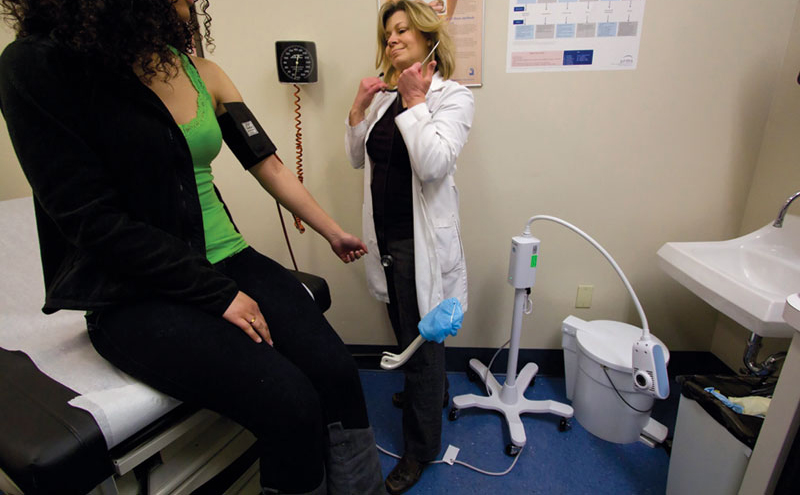
What Will Texas’ New Repro Health Safety Net Look Like?

Above: Texas lawmakers cut family planning funds, booted Planned Parenthood — pictured here, a Waco clinic — from providing state-funded health services and retooled the safety net, and now they've got to figure out which services are covered, and how, by the July 1 launch of the new programs.
As the summer launch date for Texas’ retooled state-funded women’s health programs approaches, family planning providers and advocates want to know why services like hypertension and postpartum screenings have so far been left off the lists of proposed benefits.
The Health and Human Services Commission released draft rules for the new Healthy Texas Women (HTW) and Expanded Family Planning Programs in early April, detailing the services that each program will cover. The redesign comes four years after the Legislature cut family planning funding by more than two-thirds and then created a complicated, and less effective and efficient, web of services in the wake of lawmakers’ ouster of Planned Parenthood as a safety net provider.
According to the draft rules, the new Healthy Texas Women (HTW) program — a consolidation of what is now the Texas Women’s Health Program and the Expanded Primary Health Care program — will cover birth control, lab testing, vaccines and breast and cervical cancer screenings. The Expanded Family Planning Program will cover the same services, plus prenatal care.
For the last eight months, the Women’s Health Advisory Committee (WHAC) — made up of family planning providers, advocates and physicians — has been working with the agency to retool the safety net ahead of the programs’ July 1 launch.
The benefits lists, though, lack detail on whether things like screenings and treatment for hypertension, high cholesterol or diabetes will also be covered. Dr. Moss Hampton, WHAC member and chair of the OB-GYN department at Texas Tech Health Science Center in Midland, said when patients visit his clinic for a well-woman exam or birth control, they often have other problems like breast lumps, respiratory issues or high cholesterol. Striking the appropriate balance between covering traditional family planning services and primary care is key, he said.
“Why did [HHSC] leave out hypertension, diabetes and cholesterol [screenings] when that was just a big focus a meeting or two ago?” Hampton said. “If you’re going to do a bunch of family planning, you also have to have some funding to take care of other problems that these ladies have.”
Under HTW, poor pregnant women who are on Medicaid will be automatically enrolled in the program after their Medicaid coverage expires 60 days postpartum, a change providers and advocates see as a long overdue way to streamline enrollment so women don’t lose services. An HHSC spokesperson told the Observer that postpartum services will be covered under the new programs, but advocates want that in writing.
“For the health of babies and mothers, and in line with the intent of the programs, it’s important to make clear that, in addition to contraception, HTW and [the Expanded Family Planning Program] also cover screening and treatment for hypertension, postpartum depression, and other key health risks,” said Adriana Koehler, senior health policy associate at Texans Care for Children, in a statement.
Although whether these services will be covered, and how, remains unclear, one thing is certain: Neither program will cover abortion, or allow an “abortion affiliate” — in the state’s view, a provider like Planned Parenthood — to participate, per state law. In fact, HHSC emphasizes the so-called “abortion affiliate ban” throughout the draft rules, in which the term “abortion” appears 58 times, as opposed to the 29 times for “family planning,” the phrase that best describes the programs’ mission.
The rules also say that neither program will cover emergency contraception, often referred to by the brand name Plan B.
Alice Bufkin, policy and advocacy director with the Texas Women’s Healthcare Coalition, a nonprofit which represents over 60 health organizations, said the programs should cover the “full range” of FDA-approved contraceptive methods, including Plan B. On top of that, Bufkin said, the state should ensure that all forms of contraception are available “on site, when women need them.”
She also said that finding enough providers to meet patient demand is as important as clarifying what services will be covered. Both university research and the state’s own health department data show that family planning services provided under the safety net have declined or become more difficult to access following funding cuts and program reshuffling.
After Texas cut family planning funding in 2011, 82 specialty family planning clinics shut down across the state. And after booting Planned Parenthood from its Medicaid Women’s Health Program in 2012, the state created the Texas Women’s Health Program, which, according to state data, has served thousands fewer women than its predecessor.
According to a recent study by the University of Texas at Austin’s Texas Policy Evaluation Project (TxPEP), fewer women received some kinds of contraceptive services and subsequently had more Medicaid births after the Planned Parenthood ouster, despite lawmakers’ assurances that the network of providers has reached “record highs.”
Even with an additional $50 million that the Texas Legislature funneled to women’s health last session, approximately 1.8 million Texans still need publicly funded family planning care, according to the Guttmacher Institute. And more than half of Texas women still face barriers when accessing reproductive health care, struggling with cost, travel and getting time off work, TxPEP researchers found.
“It’s really important that we have strong state programs, especially in rural areas and underserved areas,” Bufkin said. “We need providers to know about the programs, be encouraged and want to participate.”
Healthcare providers have until April 21 to submit their applications to participate in the new programs. HHSC is taking public comment on the draft rules until April 24 in advance of the next WHAC meeting on April 26.


